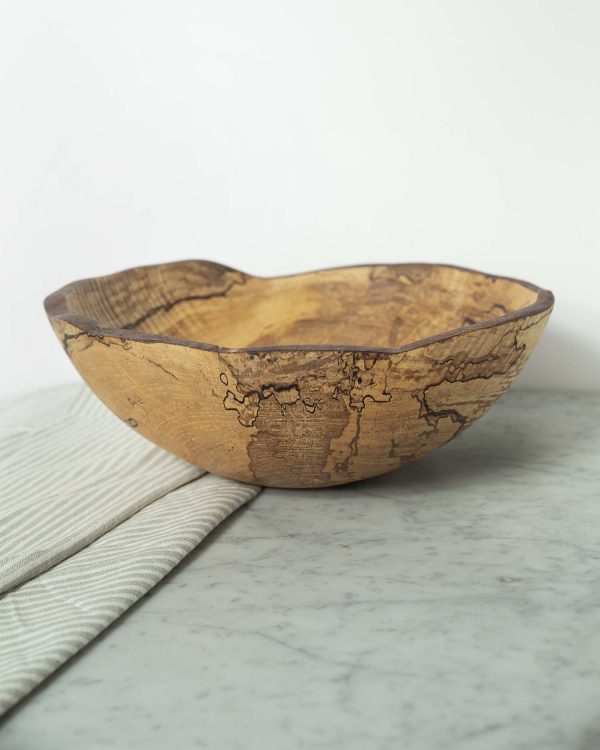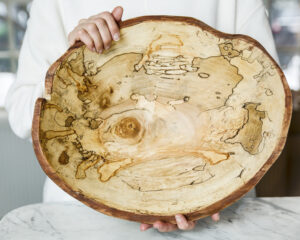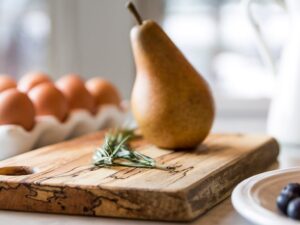We use spalted maple to create some of our most beautiful boards, bowls, and tossers. But what is spalted maple?
Our one-of-a-kind spalted maple pieces are known for their gorgeous, meandering lines reminiscent of an antique map or a child’s drawing. Our customers often ask us how these patterns are formed in nature.
In this post, we’re going to dig deep into exactly what spalted maple wood is and how it’s created.
What is Spalted Wood?
Spalting is a process in which fungi alter the appearance of wood. This most commonly happens during the early stages of decomposition in fallen logs. Spalting sometimes occurs in living trees that are under stress. It’s also possible to recreate the natural conditions that lead to spalting on your own, to get the same results.
The fact that fungi are involved in the spalting process might make some folks pause. Fear not, our spalted wood pieces are 100% food safe.
Depending on the conditions and fungi species involved, the spalting process can color wood, bleach it, or create patterns of winding lines.
We work with spalted maple, but spalting can occur in any wood species. Spalting typically occurs in hardwoods, but can be found in softwoods, too. It’s most often found in maple, beech, and birch.
Spalted wood shouldn’t be used for load-bearing purposes. However, it can add incredible beauty to furniture, guitars, and of course, boards and bowls.
How is Spalted Maple Created?
All spalted maple is created by fungi, but how do fungi create those line patterns in wood?
These lines are created by fungi in the early stages of the natural decomposition process. They are known as “zone lines” because they are typically created when two or more fungi meet in the wood. When these fungi cross paths, they may raise barriers of sorts to protect themselves from the other fungi, or two fungi may fight for dominance. These battle lines are the patterns you see in our spalted maple.
Some fungi create these lines on their own. Xylaria polymorpha, or “dead man’s finger,” is one of the most common line-creating fungi out there, spalting wood the world over. It’s also known for its ability to make patterns without an opponent.
How We Create Our Spalted Maple Boards and Bowls
Our spalted maple boards, bowls, and tossers are truly a collaboration between humans and nature.
At Spencer Peterman, we are committed to sustainability. We work exclusively with locally sourced logs that would otherwise be chipped, burned, or tossed. We love giving this wood new life as beautiful and functional pieces for your home and kitchen.
Working with spalted maple requires expertise. The natural decomposition process must be interrupted at the exact right moment, when the fungi has done its work, but before the wood becomes too soft. All of our spalted maple bowls, boards, and salad tossers are handcrafted in our workshops in Western Massachusetts by our expert woodworkers.
With the proper care, our handcrafted pieces can last a lifetime. Learn more about how to care for our handmade bowls and boards.
Our Spalted Maple Collection
Our Classic Round Bowls feature a clean edge, and range in size from 10 to 21 inches in diameter.
Featuring a live edge and an organic, oval shape, our Live Edge Oval Bowls range in size from 10 to 21 inches.
Our Harvest Bowls boast exquisitely placed handles. They are ideal for serving a family sized salad, gathering garden produce, or simply creating a centerpiece or counter top display of fresh fruit.
Our Rectangular Cutting Boards are wonderful for preparing and serving food, and will bring your charcuterie game to the next level.
These Round Cutting Boards and Oval Cutting Boards make an excellent cutting board or serving tray for breads, cheeses and charcuterie.
Enjoy a fresh baked baguette on our gorgeous Baguette Cutting Boards!
Our Salad Tossers come in three sizes. Pair them with one of our ebonized black bowls to make both colors pop!
We hope you enjoyed this tour of our spalted maple collection, and this deep dive into the natural processes behind our spalted maple creations.














